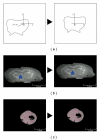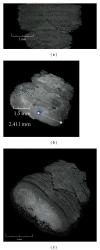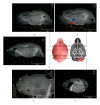Development of a New Tool for 3D Modeling for Regenerative Medicine
- PMID: 21776249
- PMCID: PMC3132439
- DOI: 10.1155/2011/236854
Development of a New Tool for 3D Modeling for Regenerative Medicine
Abstract
The effectiveness of therapeutic treatment based on regenerative medicine for degenerative diseases (i.e., neurodegenerative or cardiac diseases) requires tools allowing the visualization and analysis of the three-dimensional (3D) distribution of target drugs within the tissue. Here, we present a new computational procedure able to overcome the limitations of visual analysis emerging by the examination of a molecular signal within images of serial tissue/organ sections by using the conventional techniques. Together with the 3D anatomical reconstitution of the tissue/organ, our framework allows the detection of signals of different origins (e.g., marked generic molecules, colorimetric, or fluorimetric substrates for enzymes; microRNA; recombinant protein). Remarkably, the application does not require the employment of specific tracking reagents for the imaging analysis. We report two different representative applications: the first shows the reconstruction of a 3D model of mouse brain with the analysis of the distribution of the β-Galactosidase, the second shows the reconstruction of a 3D mouse heart with the measurement of the cardiac volume.
Figures








Similar articles
-
2D and 3D MALDI-imaging: conceptual strategies for visualization and data mining.Biochim Biophys Acta. 2014 Jan;1844(1 Pt A):117-37. doi: 10.1016/j.bbapap.2013.01.040. Epub 2013 Mar 4. Biochim Biophys Acta. 2014. PMID: 23467008
-
An analytical tool that quantifies cellular morphology changes from three-dimensional fluorescence images.J Vis Exp. 2012 Aug 31;(66):e4233. doi: 10.3791/4233. J Vis Exp. 2012. PMID: 22951512 Free PMC article.
-
Three-dimensional transmission electron microscopy and its application to mitosis research.Methods Cell Biol. 1999;61:81-111. doi: 10.1016/s0091-679x(08)61976-7. Methods Cell Biol. 1999. PMID: 9891310 Review.
-
3D thermal medical image visualization tool: Integration between MRI and thermographic images.Annu Int Conf IEEE Eng Med Biol Soc. 2014;2014:5583-6. doi: 10.1109/EMBC.2014.6944892. Annu Int Conf IEEE Eng Med Biol Soc. 2014. PMID: 25571260
-
[3D ultrasonography for examination of the musculoskeletal system].Acta Chir Orthop Traumatol Cech. 2006 Dec;73(6):414-20. Acta Chir Orthop Traumatol Cech. 2006. PMID: 17266845 Review. Czech.
References
-
- Martino S, D’Angelo F, Armentano I, et al. Hydrogenated amorphous carbon nanopatterned film designs drive human bone marrow mesenchymal stem cell cytoskeleton architecture. Tissue Engineering. Part A. 2009;15(10):3139–3149. - PubMed
-
- Martino S, di Girolamo I, Cavazzin C, et al. Neural precursor cell cultures from GM2 gangliosidosis animal models recapitulate the biochemical and molecular hallmarks of the brain pathology. Journal of Neurochemistry. 2009;109(1):135–147. - PubMed
-
- Quattrocelli M, Cassano M, Crippa S, Perini I, Sampaolesi M. Cell therapy strategies and improvements for muscular dystrophy. Cell Death and Differentiation. 2010;17(8):1222–1229. - PubMed
-
- Lattanzi A, Neri M, Maderna C, et al. Widespread enzymatic correction of CNS tissues by a single intracerebral injection of therapeutic lentiviral vector in leukodystrophy mouse models. Human Molecular Genetics. 2010;19(11):2208–2227. - PubMed
LinkOut - more resources
Full Text Sources

